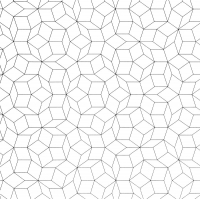Forbidden Symmetries
Letter 01 (European Kunsthalle), Vienna 2015
Lace-Making and Penrose Tiling
Concept and Realisation by Dorothee Goerke and Katrin Mayer
.
European Kunsthalle @ chambre d´amis / Semperdepot, Vienna
invited by Vanessa Joan Müller and Dorit Margreiter
In "Forbidden Symmetries", Katrin Mayer combines ideas on quasicrystals and their aperiodic patterns with the art of lace-making that is based on mathematical and geometric calculations producing symmetrical patterns. Although lace is considered a supplementary textile decoration, it follows a complex logic that combines seriality, geometry and an abstract translation of natural forms into ornamentation. "Forbidden Symmetries" transfers a quasicrystalline structure in an expansive piece of lace and thus confronts two systems that show similarities, but also essential differences regarding repeatability, structural rules, historicity and gender.
In his writings, Gottfried Semper (1803-1879) repeatedly draws connections between nodes, networks, braids, lace works, mats, fabrics and architecture. Going back to Semper and his revision of the aesthetic and ideological polarization of surface and substance, autonomous creation and decoration, Katrin Mayer unfolds on site at the historical Semperdepot in Vienna a visual and discursive linking of various considerations on lace work as an interaction of intertwined threads. In her project, both the secret language of the bobbin letter and the abstract knowledge transfer of disparate fields are addressed, which in turn create new sets of relationships.
Katrin Mayer was invited by European Kunsthalle. As a discursive platform without a physical location of its own, European Kunsthalle has developed its own approach to institutional practice. The current activities focus on decentralised projects as well as a collaborative structure. As an institution without a permanent site, European Kunsthalle is targeting overall performative presence: it exists in the very places where its projects are happening.
.
together with:
Joint Book Launch
Textiles: Open Letter, edited by Rike Frank and Grant Watson in cooperation with Sabine Folie, Georgia Holz, and Susanne Titz for the Generali Foundation, Vienna, and Museum Abteiberg, Mönchengladbach, Sternberg Press, Berlin, 2015.
see:
http://textiles-open-letter
http://foundation.generali.at/en/study-center/publication/textiles.html
and
Textile Theorien der Moderne. Alois Riegl in der Kunstkritik, edited by Sabeth Buchmann and Rike Frank, PoLYpeN / b_books, Berlin 2015.
.
.
Ausserdem in der Ausstellung "Dinge und Dialoge", Scriptings/Berlin and Saprophyt/Vienna, Berlin, 2016
kuratiert von Barbara Kapusta, Jenni Tischer and Rocco Pagel
mit Daniel Heinrich, Kathi Hofer, Barbara Kapusta, Ulrike Köppinger, Katrin Mayer, Ulrike Müller, Rocco Pagel, Jenni Tischer
http://www.saprophyt.net/dinge-und-dialoge/
- Gespräch Martin Beck und Katrin Mayer
http://www.saprophyt.net/dinge-und-dialoge-veranstaltung/
In der Arbeit “Forbidden Symmetries”, setzt Katrin Mayer die aperiodische Struktur der Quasikristalle in Dialog mit der Handarbeitstechnik des Klöppelns, welche auf mathematischen, geometrischen Kalkulationen basierend symmetrische Muster erzeugt. Trotzdem es sich dabei in seiner eigentlichen Form um ein dekoratives Kunsthandwerk handelt, zeichnet sich dieses aber durch eine komplexe Logik aus, die Serialität, Geometrie und eine abstrakte Übersetzung von organischen Formen in eine ornamentale Form kombiniert. Die Arbeit entstand in engem Austausch mit Martin Beck, dessen Interesse für Quasikristalle und sogenannte ‘verbotene Symmetrien’ sich aus der Zusammenarbeit mit dem Künstler Gerard Caris (*1925) ergibt, der seit den 60er Jahren die Frage der Realisation ‘verbotener’ fünfzahliger Symmetrien in das Zentrum seiner gestalterischen Arbeit stellt. Dabei entdeckte er unabhängig von der Wissenschaft Ansätze zu regelmäßigen aperiodischen Strukturen wie zweidimensionalen Penrose-Parkettierungen und dreidimensionalen Quasikristallen. Erhielt Caris nach eigener Aussage noch in den 80er Jahren Anrufe von Wissenschaftlern, die sagten “I don’t believe this exists!”, so sind Quasikristalle – seit ihrer experimentellen Entdeckung 1982 und der Verleihung des Nobelpreises an Daniel Shechtman dafür 2011 – von einem für unmöglich gehaltenen Bereich der Kristallographie zu einer Zukunftstechnologie geworden.
(Martin Beck)
.
.











